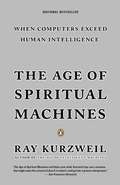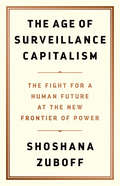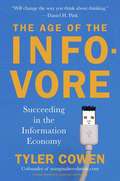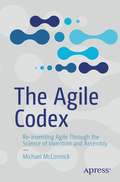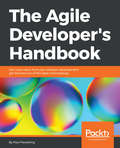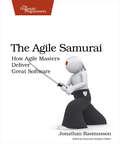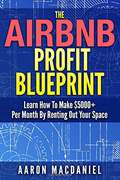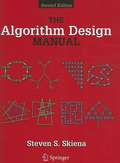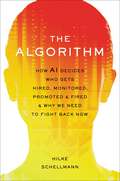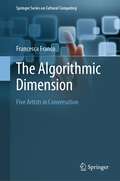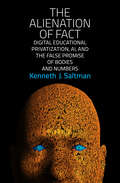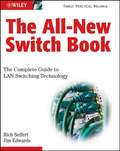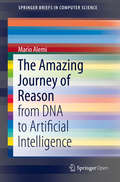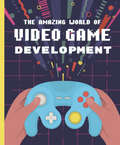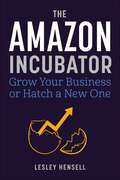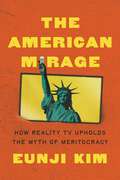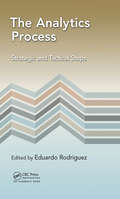- Table View
- List View
The Age of Spiritual Machines: When Computers Exceed Human Intelligence
by Ray KurzweilRay Kurzweil is the inventor of the most innovative and compelling technology of our era, an international authority on artificial intelligence, and one of our greatest living visionaries. Now he offers a framework for envisioning the twenty-first century--an age in which the marriage of human sensitivity and artificial intelligence fundamentally alters and improves the way we live. Kurzweil's prophetic blueprint for the future takes us through the advances that inexorably result in computers exceeding the memory capacity and computational ability of the human brain by the year 2020 (with human-level capabilities not far behind); in relationships with automated personalities who will be our teachers, companions, and lovers; and in information fed straight into our brains along direct neural pathways. Optimistic and challenging, thought-provoking and engaging, The Age of Spiritual Machines is the ultimate guide on our road into the next century.
The Age of Surveillance Capitalism: The Fight for a Human Future at the New Frontier of Power
by Shoshana ZuboffThe challenges to humanity posed by the digital future, the first detailed examination of the unprecedented form of power called "surveillance capitalism," and the quest by powerful corporations to predict and control our behavior. <P><P>Shoshana Zuboff's interdisciplinary breadth and depth enable her to come to grips with the social, political, business, and technological meaning of the changes taking place in our time. We are at a critical juncture in the confrontation between the vast power of giant high-tech companies and government, the hidden economic logic of surveillance capitalism, and the propaganda of machine supremacy that threaten to shape and control human life. <P><P>Will the brazen new methods of social engineering and behavior modification threaten individual autonomy and democratic rights and introduce extreme new forms of social inequality? Or will the promise of the digital age be one of individual empowerment and democratization? <P><P>The Age of Surveillance Capitalism is neither a hand-wringing narrative of danger and decline nor a digital fairy tale. Rather, it offers a deeply reasoned and evocative examination of the contests over the next chapter of capitalism that will decide the meaning of information civilization in the twenty-first century. The stark issue at hand is whether we will be the masters of information and machines or its slaves.
The Age of the Infovore: Succeeding in the Information Economy
by Tyler CowenTyler Cowen shows that our super networked world is changing the way we think and empowering us to thrive in new ways. He shows you how to manage the massive daily flow of data better, no matter how adept you may already be at Facebooking, watching television, or studying for that test.
The Agile Codex: Re-inventing Agile Through the Science of Invention and Assembly
by Michael McCormickApply the industrial engineering science of invention and assembly to how software is described, planned, and built, allowing you to be free to flex your practices according to your needs, putting principle over habit and rules.Reading about Agile practices is like reading diet advice. Everything sounds unique and good; everything starts with good intentions. Then reality sets in. Organizations adapt their practices, but lose sight of grounding principles. A bias toward ceremonies, metrics, and recipes comes at the expense of efficiently getting the real work done. Managers and developers are incentivized to game the system. Organizational metrics become detached from the reality of what is being delivered and how.The Agile Codex shows you how to describe a software project as an acyclic dependency tree of sized work items, scoped to be operated on by one software engineer each and completed within a week. It provides Open Source tooling to help you visualize, sequence and assign these work items to account for risk and increase predictability in your delivery times. You’ll see the value of doing this as it applies to efficiently planning and adjusting software projects in the face of learning and change. Finally, the book covers the collaborative agile principles required to bring this skill set and practice to a software team.Throughout the book you’ll be reminded that software engineering is not a rote task - it is primarily a skilled, creative act. As such, you’ll see that we need to account for the space needed to research, plan, create, and adjust. The Agile practices serving the codex deal with this intersection between the engineering problem of software delivery flow, and the human reality of how work is described, owned, executed, and transitioned from one state to another.Everything an agile team does must serve the codex. The creation and the care and feeding of this structured tree of work sets the frame in which all other team actions take place and against which all successes or failures can be evaluated.
The Agile Developer's Handbook: Get more value from your software development: get the best out of the Agile methodology
by Paul FlewellingA pragmatic companion guide to your Agile journey Key Features Make your team Agile by implementing industry-standard Agile techniques Assess scope, scale up efficiently Create the correct roles and identify the right candidates for your team Finish your projects faster and stay ahead of the curve Book Description This book will help you overcome the common challenges you’ll face when transforming your working practices from waterfall to Agile. Each chapter builds on the last, starting with easy-to-grasp ways to get going with Agile. Next you’ll see how to choose the right Agile framework for your organization. Moving on, you’ll implement systematic product delivery and measure and report progress with visualization. Then you’ll learn how to create high performing teams, develop people in Agile, manage in Agile, and perform distributed Agile and collaborative governance. At the end of the book, you’ll discover how Agile will help your company progressively deliver software to customers, increase customer satisfaction, and improve the level of efficiency in software development teams. What you will learn Create a solid foundation that gives your team an Agile jumpstart Understand how to select and evolve practices to increase your team’s agility Use experiments to accelerate your team’s understanding Fine-tune your approach by incorporating aspects of Lean and Lean Startup Know how to foster an environment of continuous improvement and learning that will become self-sustainingWho this book is for If you’re a software developer or a project manager with little to no experience of Agile, but you want to efficiently implement it, this is the book for you.
The Agile Samurai: How Agile Masters Deliver Great Software
by Jonathan RasmussonPrinted in full color. Faced with a software project of epic proportions? Tired of over-committing and under-delivering? Enter the dojo of the agile samurai, where agile expert Jonathan Rasmusson shows you how to kick-start, execute, and deliver your agile projects. Combining cutting-edge tools with classic agile practices, The Agile Samurai gives you everything you need to deliver something of value every week and make rolling your software into production a non-event. Get ready to kick some software project butt. By learning the ways of the agile samurai you will discover: how to create plans and schedules your customer and your team can believe inwhat characteristics make a good agile team and how to form your ownhow to gather requirements in a fraction of the time using agile user storieswhat to do when you discover your schedule is wrong, and how to look like a pro correcting ithow to execute fiercely by leveraging the power of agile software engineering practices By the end of this book you will know everything you need to set up, execute, and successfully deliver agile projects, and have fun along the way. If you're a project lead, this book gives you the tools to set up and lead your agile project from start to finish. If you are an analyst, programmer, tester, usability designer, or project manager, this book gives you the insight and foundation necessary to become a valuable agile team member. The Agile Samurai slices away the fluff and theory that make other books less-than-agile. It's packed with best practices, war stories, plenty of humor and hands-on tutorial exercises that will get you doing the right things, the right way. This book will make a difference.
The Airbnb Profit Blueprint: Learn How To Make $5000+ Per Month By Renting Out Your Space
by Aaron MacDanielHave you ever heard about AirBnB but aren't sure how to get started? Or are you an AirBnB host already looking for ways to maximize your bookings, increase your AirBnB ranking, and reduce the amount of time you spend working on your listing? Then you have come to the right place!AirBnB is a very flexible platform, and it can work for a variety of situations. Do you have a spare room in your house or apartment? It could even be your living room, a trailer, a boat, or an igloo (there was a very popular igloo in Boston last winter), there are very few limits as to what you can rent out on Airbnb. Or maybe you want to go to the next level and rent out your entire home or apartment on AirBnB while you travel or live elsewhere? Then we have a blueprint to get you started and show you exactly what to do.This book will help the complete novice and experienced AirBnB host alike, as there are tips for students at every level. I walk you through everything you need to know about renting out your spare room or your entire apartment on AirBnB.
The Algorithm Design Manual
by Steven S. SkienaSkiena focuses on the practical aspects of algorithm design and use. This work fills an important gap in the knowledge of CS practitioners and students. This book is suitable as a text for an undergraduate algorithms class, but also as an invaluable reference for the practicing programmer. This second edition has updated the bibliography to include recent works, making it an extensive bibliography. The index is also thorough and very useful for finding specific problems
The Algorithm: How AI Decides Who Gets Hired, Monitored, Promoted, and Fired and Why We Need to Fight Back Now
by Hilke SchellmannBased on exclusive information from whistleblowers, internal documents, and real world test results, Emmy‑award winning Wall Street Journal contributor Hilke Schellmann delivers a shocking and illuminating expose on the next civil rights issue of our time: how AI has already taken over the workplace and shapes our future. Hilke Schellmann, is an Emmy‑award winning investigative reporter, Wall Street Journal and Guardian contributor and Journalism Professor at NYU. In The Algorithm, she investigates the rise of artificial intelligence (AI) in the world of work. AI is now being used to decide who has access to an education, who gets hired, who gets fired, and who receives a promotion. Drawing on exclusive information from whistleblowers, internal documents and real‑world tests, Schellmann discovers that many of the algorithms making high‑stakes decisions are biased, racist, and do more harm than good. Algorithms are on the brink of dominating our lives and threaten our human future—if we don't fight back. Schellmann takes readers on a journalistic detective story testing algorithms that have secretly analyzed job candidates' facial expressions and tone of voice. She investigates algorithms that scan our online activity including Twitter and LinkedIn to construct personality profiles à la Cambridge Analytica. Her reporting reveals how employers track the location of their employees, the keystrokes they make, access everything on their screens and, during meetings, analyze group discussions to diagnose problems in a team. Even universities are now using predictive analytics for admission offers and financial aid.
The Algorithmic Dimension: Five Artists in Conversation (Springer Series on Cultural Computing)
by Francesca FrancoFifty years after the first experiments in computational art, international interest in the history of this subject remains strong and at the same time almost uncovered. This book began with the exhibition Algorithmic Signs, which was conceived, researched and curated by Francesca Franco in Venice in 2017. The origins of the exhibition included a series of meetings that gathered together the most celebrated international pioneers in the world of digital arts and the rare opportunity to interview them in their studios.Francesca Franco explores the history of computer art and its contribution to the broader field of contemporary art from the 1960s to the present. It is illustrated by the creative work of five of the most influential pioneers of computer art - Ernest Edmonds, Manfred Mohr, Vera Molnár, Frieder Nake, and Roman Verostko and includes the full visual documentation of the exhibition.The Algorithmic Dimension - Five Artists in Conversation offers more than a theoretical perspective; it offers readers the rare opportunity to hear the histories and developments of the fascinating art, created through the algorithm, in an accessible and stimulating narrative. The personal achievements of each artist are followed, including their original inspirations, and how they develop in parallel with technological advances. It also brings together for the first time the artists' common ideas and differences, and tales about how their paths have crossed over the years.
The Alien Conspiracy: An Unofficial Fortnite Novel (Battle Royale #2)
by Cara J. StevensOn an island where everyone is a warrior, only the strong survive. The Impossibles, a squadron of inexperienced soldiers, have been recruited from across the globe, tasked with the directive to train, fight, and win the ultimate victory in Fortnite’s Battle Royale. In this series of Fortnite novelizations, follow Zane, Jax, Asha, Jin, and Blaze as they seek out adventure, uncover mysteries, and battle to become the ultimate winners of the Battle Royale. The second book in this exciting new series, The Alien Conspiracy, leaps into their second thrilling adventure: Jin has always had his theories about what is happening on the island, but now it turns out they may not be that far-fetched after all: the mysteries from outer space and the comet, the rocket, and The Visitor—alien or impostor?
The Alienation of Fact: Digital Educational Privatization, AI, and the False Promise of Bodies and Numbers
by Kenneth J. SaltmanAn investigation of the role of educational privatization and technology in the crises of truth and agency.Today, conspiracy theories run rampant, attacks on facts have become commonplace, and systemic inequities are on the rise as individual and collective agency unravels. The Alienation of Fact explains the educational, technological, and ideological preconditions for these contemporary crises of truth and agency and explores the contradictions and competing visions for the future of education that lie at the center of the problem. Schools are increasingly reimagined as businesses, and high-stakes standardized testing and curricula, for-profit charter schools, and the rise of educational AI put capital and technology at the center of education. Yet even as our society demands measure, data, and facts, politicians and news outlets regularly make unfounded assertions. How should we make sense of the contradictions between the demand for radical data-driven empiricism and the flight from evidence, argument, or theoretical justification? In this critical investigation of the new digital directions of educational privatization—AI education, adaptive learning technology, biometrics, the quantification of play and social emotional learning—and the politics of the body, Saltman shows how the false certainty of bodies and numbers replaces deliberative and thoughtful agency in a time of increasing precarity. A distinctive contribution to scholarship on public school privatization and educational technology, politics, policy, pedagogy, and theory, The Alienation of Fact is a spirited call for democratic education that values creating a society of &“thinking people&” over capitalistic gains.
The Alignment Problem: Machine Learning And Human Values
by Brian ChristianA jaw-dropping exploration of everything that goes wrong when we build AI systems and the movement to fix them. Today’s “machine-learning” systems, trained by data, are so effective that we’ve invited them to see and hear for us—and to make decisions on our behalf. But alarm bells are ringing. Recent years have seen an eruption of concern as the field of machine learning advances. When the systems we attempt to teach will not, in the end, do what we want or what we expect, ethical and potentially existential risks emerge. Researchers call this the alignment problem. Systems cull résumés until, years later, we discover that they have inherent gender biases. Algorithms decide bail and parole—and appear to assess Black and White defendants differently. We can no longer assume that our mortgage application, or even our medical tests, will be seen by human eyes. And as autonomous vehicles share our streets, we are increasingly putting our lives in their hands. The mathematical and computational models driving these changes range in complexity from something that can fit on a spreadsheet to a complex system that might credibly be called “artificial intelligence.” They are steadily replacing both human judgment and explicitly programmed software. In best-selling author Brian Christian’s riveting account, we meet the alignment problem’s “first-responders,” and learn their ambitious plan to solve it before our hands are completely off the wheel. In a masterful blend of history and on-the ground reporting, Christian traces the explosive growth in the field of machine learning and surveys its current, sprawling frontier. Readers encounter a discipline finding its legs amid exhilarating and sometimes terrifying progress. Whether they—and we—succeed or fail in solving the alignment problem will be a defining human story. The Alignment Problem offers an unflinching reckoning with humanity’s biases and blind spots, our own unstated assumptions and often contradictory goals. A dazzlingly interdisciplinary work, it takes a hard look not only at our technology but at our culture—and finds a story by turns harrowing and hopeful.
The All-New Switch Book
by Rich SeifertThis much-needed update to the bestselling guide on the extensive changes to the local area networks (LAN) switching technologies explains why LAN switching technologies are critical to network design. This in-depth guide covers the capabilities, application, and design of LAN switches and switched internetworks and examines the significant changes that have taken place since the publication of the first edition seven years ago. You're sure to appreciate the witty writing style and easy-to-follow format on such an often-complicated subject matter.
The Amazing Journey of Reason: from DNA to Artificial Intelligence (SpringerBriefs in Computer Science)
by Mario AlemiThis Open Access book explores questions such as why and how did the first biological cells appear? And then complex organisms, brains, societies and –now– connected human societies? Physicists have good models for describing the evolution of the universe since the Big Bang, but can we apply the same concepts to the evolution of aggregated matter –living matter included? The Amazing Journey analyzes the latest results in chemistry, biology, neuroscience, anthropology and sociology under the light of the evolution of intelligence, seen as the ability of processing information. The main strength of this book is using just two concepts used in physics –information and energy– to explain: The emergence and evolution of life: procaryotes, eukaryotes and complex organismsThe emergence and evolution of the brainThe emergence and evolution of societies (human and not)Possible evolution of our "internet society" and the role that Artificial Intelligence is playing
The Amazing World of Quantum Computing (Undergraduate Lecture Notes in Physics)
by Rajendra K. BeraThis book discusses the application of quantum mechanics to computing. It explains the fundamental concepts of quantum mechanics and then goes on to discuss various elements of mathematics required for quantum computing. Quantum cryptography, waves and Fourier analysis, measuring quantum systems, comparison to classical mechanics, quantum gates, and important algorithms in quantum computing are among the topics covered.The book offers a valuable resource for graduate and senior undergraduate students in STEM (science, technology, engineering, and mathematics) fields with an interest in designing quantum algorithms. Readers are expected to have a firm grasp of linear algebra and some familiarity with Fourier analysis.
The Amazing World of Video Game Development
by Denis GalaninThe perfect book for any child who is interested in making a career out of video games, learn about the different roles within a game development company and how a game goes from a thought to a program.
The Amazon Economy
by Financial TimesThe Amazon Economy tells you everything you need to know about Amazon, the technological giant that is now much more than the online retailer founded by Jeff Bezos in 1994. The company’s voracious expansion—into areas ranging from logistics and cloud computing to fashion and movie production—has put it at the head of a wider corporate ecosystem over which it wields extraordinary power. Regulators, politicians, consumers and other businesses ignore it at their peril. Based on a series of articles published by the Financial Times, The Amazon Economy has been specially updated as an e-book by Barney Jopson, U.S. retail correspondent for the global business newspaper and website, with contributions from the FT’s influential Lex columnists, Robert Armstrong and Stuart Kirk, and global media editor, Andrew Edgecliffe-Johnson.
The Amazon Incubator: Grow Your Business or Hatch a New One
by Lesley HensellThe real story about how to be a successful seller on Amazon, from a leading consultant. Amazon is the most powerful business incubator in the history of the world. Unfortunately, where there is great opportunity, get-rich-quick schemes abound. Most available books about selling on Amazon peddle a dream that is unattainable for sellers. They promise riches at the cost of only five hours a week, or a long-term income for an initial investment of just $1,000.The Amazon Incubator is different. This book instead offers realistic, sustainable strategies for building a long-term, profitable business on Amazon. Whether sellers are burgeoning entrepreneurs or own the ecommerce channel at an established brand, they will benefit from the strategic thinking and in-depth Amazon know-how delivered in an easily digestible format. The reader will be guided through exercises to define their goals, determine their product set, and execute like a champ. The Amazon Incubator is written in short, easy-to-digest chapters that include case studies and real-world examples of Amazon seller success and failure. Readers will better identify with and understand the information when case studies are included. In addition, each chapter includes a brief summary at the end, as well as suggested action steps, so it can easily be used as a tool for the reader to share with teammates and business associates.
The Ambient Intelligent Classroom: Beyond the Indispensable Educator (Studies in Computational Intelligence #840)
by Matthew MontebelloThis book explores Ambient Intelligence as applied to the classroom, while especially focusing on the use of personalized education to optimize the learning process. In the years to come, the dynamics of learning spaces in higher education will need to evolve and adapt to a constantly changing digital society, as learners and educators alike attune their learning competences and teaching skills. Ambient Intelligence is another way that Artificial Intelligence is being utilized in a plethora of real-world situations, amongst which classrooms and other learning spaces offer fitting settings and ideal environments for employing this assistive technology.The book presents a complete and novel approach to deploying the Ambient Intelligent Classroom, based on three interrelated aspects – the Social, the Technological and the Educational, – in order to provide a rich three-dimensional learning environment.This book is intended for education technologists and AI researchers, as well as for those tech-savvy readers interested in applying technology to the future of learning spaces. Educators in particular will find valuable insights and guidelines on how to shape the evolution of their own classroom.
The American Midwest: Managing Change in Rural Transition
by Norman WalzerThe rural Midwest is undergoing fundamental changes with increased competition from foreign agriculture; employment shifts from higher-paying manufacturing to lower-paying service industries; the displacement of local small town business by large discount stores and shopping malls; overall population declines that threaten the viability of schools, hospitals, and other public institutions, along with an influx of minority groups that has led to strife in some communities. Using data from the 2000 Census, this collection examines the major demographic and employment trends in the rural Midwestern states with special attention to the issues that state and local policy makers must address in the near future. The contributors are well known experts in their fields, and in these original, previously unpublished materials they offer suggestions on how the Internet and other technological advances offer new opportunities for rural economies that local leaders can build on.
The American Mirage: How Reality TV Upholds the Myth of Meritocracy (Princeton Studies in Political Behavior)
by Eunji KimHow the entertainment narrative of upward mobility distorts the harsh economic realities in AmericaIn an age of growing wealth disparities, politicians on both sides of the aisle are sounding the alarm about the fading American Dream. Yet despite all evidence to the contrary, many still view the United States as the land of opportunity. The American Mirage addresses this puzzle by exposing the stark reality of today&’s media landscape, revealing how popular entertainment media shapes politics and public opinion in an increasingly news-avoiding nation.Drawing on an eclectic array of original data, Eunji Kim demonstrates how, amid a dazzling array of media choices, many Americans simply are not consuming the news. Instead, millions flock to entertainment programs that showcase real-life success stories, such as American Idol, Shark Tank, and MasterChef. Kim examines how shows like these leave viewers confoundingly optimistic about the prospects of upward mobility, promoting a false narrative of rugged individualism and meritocracy that contradicts what is being reported in the news.By taking seriously what people casually watch every day, The American Mirage shows how rags-to-riches programs perpetuate the myth of the American Dream, glorifying the economic winners, fostering tolerance for income inequality, and dampening support for redistributive policies that could improve people&’s lives.
The American Presidency: An Institutional Approach to Executive Politics
by William G. HowellHow institutions shape the American presidencyThis incisive undergraduate textbook emphasizes the institutional sources of presidential power and executive governance, enabling students to think more clearly and systematically about the American presidency at a time when media coverage of the White House is awash in anecdotes and personalities. William Howell offers unparalleled perspective on the world’s most powerful office, from its original design in the Constitution to its historical growth over time; its elections and transitions to governance; its interactions with Congress, the courts, and the federal bureaucracy; and its persistent efforts to shape public policy. Comprehensive in scope and rooted in the latest scholarship, The American Presidency is the perfect guide for studying the presidency at a time of acute partisan polarization and popular anxiety about the health and well-being of the republic.Focuses on the institutional structures that presidents must navigate, the incentives and opportunities that drive them, and the constraints they routinely confrontShows how legislators, judges, bureaucrats, the media, and the broader public shape the contours and limits of presidential powerEncourages students to view the institutional presidency as not just an object of study but a way of thinking about executive politicsHighlights the lasting effects of important historical moments on the institutional presidencyEnables students to grapple with enduring themes of power, rules, norms, and organization that undergird democracy
The Analogue Alternative: The Electronic Analogue Computer in Britain and the USA, 1930-1975 (Routledge Studies in the History of Science, Technology and Medicine #15)
by James S. SmallWe are in the midst of a digital revolution - until recently, the majority of appliances used in everyday life have been developed with analogue technology. Now, either at home or out and about, we are surrounded by digital technology such as digital 'film', audio systems, computers and telephones. From the late 1940s until the 1970s, analogue technology was a genuine alternative to digital, and the two competing technologies ran parallel with each other. During this period, a community of engineers, scientists, academics and businessmen continued to develop and promote the analogue computer. At the height of the Cold War, this community and its technology met with considerable success in meeting the urgent demand for high speed computing for use in the design and simulation of rockets, aircraft and manned space vehicles. The Analogue Alternative tracks the development, commercialisation and ultimate decline of the electronic analogue computer in the USA and Britain. It examines the roles played by technical, economic and cultural factors in the competition between the alternative technologies, but more importantly, James Small demonstrates that non-technical factors, such as the role of 'military enterprise' and the working practices of analogue engineers, have been the most crucial in analogue's demise.^l This book will be of interest to students of the history and sociology of science and technology, particularly computing. It will also be relevant to those interested in technical change and innovation, and the study of scientific cultures.
The Analytics Process: Strategic and Tactical Steps
by Eduardo RodriguezThis book is about the process of using analytics and the capabilities of analytics in today’s organizations. Cutting through the buzz surrounding the term analytics and the overloaded expectations about using analytics, the book demystifies analytics with an in-depth examination of concepts grounded in operations research and management science. Analytics as a set of tools and processes is only as effective as: The data with which it is working The human judgment applying the processes and understanding the output of these processes. For this reason, the book focuses on the analytics process. What is intrinsic to analytics’ real organizational impact are the careful application of tools and the thoughtful application of their outcomes. This work emphasizes analytics as part of a process that supports decision-making within organizations. It wants to debunk overblown expectations that somehow analytics outputs or analytics as applied to other concepts, such as Big Data, are the be-all and end-all of the analytics process. They are, instead, only a step within a holistic and critical approach to management thinking that can create real value for an organization. To develop this holistic approach, the book is divided into two sections that examine concepts and applications. The first section makes the case for executive management taking a holistic approach to analytics. It draws on rich research in operations and management science that form the context in which analytics tools are to be applied. There is a strong emphasis on knowledge management concepts and techniques, as well as risk management concepts and techniques. The second section focuses on both the use of the analytics process and organizational issues that are required to make the analytics process relevant and impactful.
